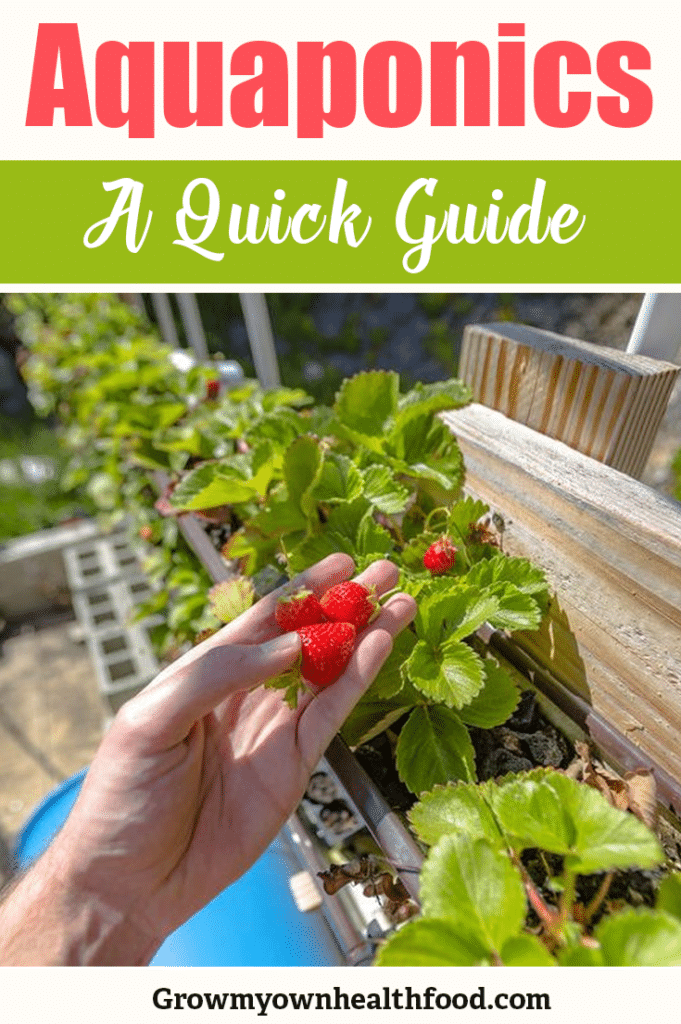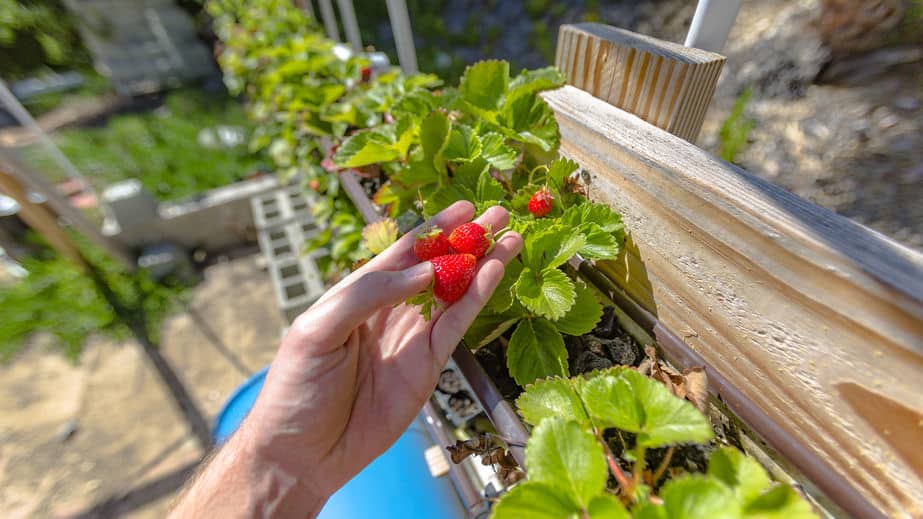No doubt there is a lot of benefits with homegrown food. But, what if you don’t have enough outdoor space for a garden in your home? Or maybe you live in a cold climate that will make gardening quite a chore. You’re not alone on this, as a lot of people are facing this challenge as well. Nevertheless, what if I tell you there is an alternative? A method that allows you to grow your food regardless of where you have space, including indoors. That method is called Aquaponics. The following is a quick guide to Aquaponics.
What is Aquaponics?
Simply put, aquaponics is a combination of hydroponic (growing soilless plants) and aquaculture (growing fish) – a unique system that mutually benefits both environments. This means you grow your plants in water instead of dirt or soil. To explain further, in an aquaponics set up, you basically expand your plants in a container that runs off right into a fish tank (where you’ve your fishes). The waste from the tank break down into minerals and nutrients that are usable by the plants.
Generally, the plants sit in a bed and grow in clay or gravel pellets. You can deliver water to the plants by exposing their roots to the tank or through a pump.
Aquaponics Equipment
- This kit has enough material to fully cycle systems with up to 100 gallons of water.
- Registration for the Aquaponic Gardening Online Course, API Freshwater Master Aquarium Test Kit, AquaUp and AquaDown (pH altering solutions), Cycling Kit and a Digital Thermometer are all included.
- Detailed instructions on how the process works and how to fully cycle your system BEFORE adding fish.
- Powdered, soluble pure ammonia & powdered, soluble seaweed to give your plants a strong start.
- Includes a Data Tracking Chart so you can follow your systems progress and spot problems early.
Prices pulled from the Amazon Product Advertising API on:
Product prices and availability are accurate as of the date/time indicated and are subject to change. Any price and availability information displayed on [relevant Amazon Site(s), as applicable] at the time of purchase will apply to the purchase of this product.
The aquaponics equipment you need will depend on the type of aquaponics system. There are three main types of aquaponics system: deep flow/deep water culture, media bed and Nutrient Film Technique (NFT). Every system require a fish tank, with the size dependent on the type and number of fishes.
- EASY TO USE AEROPONIC SYSTEM FOR YOUR HOME: The systems use aeroponic technology, allowing for increased air and oxygen to the root zone, promoting greater growth. Grow 27 plants in a small space measuring just 27 from corner to corner; 65 tall including bucket and tower. Well suited for beginners and advanced hydroponic farmers
- EASY SET-UP: The system is delivered in one box measuring 20” x 26” x 24”; Detailed installation guide included; 15 minute assembly, no tools required; Seeds not included
- GROW SMART & EAT HEALTHY: Hydroponic and aeroponic systems use a fraction of land and water compared to traditional gardening. Growing your own food at home is a sustainable food source, while also addressing food safety and security in today’s changing world
- PREMIUM QUALITY & ENVIRONMENTALLY COMPLIANT: We make our systems with the highest quality components, giving you the peace of mind to know that our system will give you great output and productivity for many years to come. The system Includes the Sicce Syncra Silent 1.5 pump and Smart WiFi Timer for irrigation automation. Aerospring are manufactured in Singapore and adheres to strict quality assurance and environmental standards
- EXCELLENT CUSTOMER SUPPORT & COMMUNITY: We pride ourselves on our customer service and support. Aerospring owners get exclusive access to our online community, for growing tips, grow guides, troubleshooting and guida
Prices pulled from the Amazon Product Advertising API on:
Product prices and availability are accurate as of the date/time indicated and are subject to change. Any price and availability information displayed on [relevant Amazon Site(s), as applicable] at the time of purchase will apply to the purchase of this product.
Deep water culture – It is mostly used in commercial set-ups, but that doesn’t mean you can’t use it for your home aquaponics system. This system uses planters, which allows the plants to sit firmly on top the tank. Which enables the roots to absorb water directly from the tank, therefore you don’t need a pump or a watering rig for this set-up.
Media bed system – This is mainly for a backyard aquaponic setup, and most home-based aquaponics system make use of this set-up. Here, planters sit either on top or alongside of a fish tank. A watering rig is then set up above the plants with a pump line running into the tank below. This helps deliver water from the tank to the plants.
If you have your media bed on top of the tank, the water from the rig will filter through the plants to fill up the tank. The media bed set-up makes use of clay or pebbles for cleaning purposes.
- Hydroponics system-Nutrient Film Technique (NFT) NFT provides no medium support for roots. Typically, roots sit in a long sloping irrigation channel (Fig 1.1). Nutrient is introduced at the high end of the channel and allowed to flow over the roots after which it drains into a nutrient reservoir. It is then re-pumped back into the channel to repeat the watering process.
- This feed cycle can be intermittent or continuous. An ¡intermittent¡¯ feed cycle is regulated by a timer and repeated many times per hour. It is sometimes termed ¡°pulsed NFT¡±. Pulsed NFT usually achieves better aeration of roots because roots are exposed to air between each feed. A ¡continuous¡¯ feed cycle runs non-stop. This is often used in commercial operations.
- you can easily grow your favourite flowers in your home without any muddy mess and need for watering the plants regularly. Hydroponics is the ideal method to grow plants in urban areas. It makes a wonderful hobby that helps you relax and it is fun to your watch plants grow in nft hydroponic garden
- Product size-100x120cm(LXH) 36 sites of net cup
- Remarks: The water reservior is not included for the unit. One unit includes, 1, tube frame-1set; 2, Hose-1.5Meter; 3, pump-1pc; 4, Foam cube and net try for starting seed-1set; 5, Machenical timer-1pc; 6, Net cup-36
Prices pulled from the Amazon Product Advertising API on:
Product prices and availability are accurate as of the date/time indicated and are subject to change. Any price and availability information displayed on [relevant Amazon Site(s), as applicable] at the time of purchase will apply to the purchase of this product.
The Nutrient Film Technique (NFT) – In NFT setups, nutrient-rich water pumps from the tank through small enclosed PVC pipes. Plants sit in small cups, with their roots growing into tiny holes openings of the pipes. This allows their roots to absorb the nutrients as the water flows.
Read our article on best starter kits.
Type of Fish to Use
You can use just about any fish in your aquaponic rig, but tilapia fishes are the most common. There are reasons for this – they are strong, and can withstand many conditions, they rarely spread diseases and they have low maintenance. Tilipia is a good choice if you plan on eating the fish. Other options for aquaponic fish include catfish, carp, goldfish, bass, bream, etc.
- Plastic plant holder with ceramic substrate planting material.
- Planter can create a healthy habitat for betta fish by replicating natures cycle.
- Plant above purifies water and absorbs fish waste as nourishment.
- Betta fish tank is easy to clean; planter is simple to remove when needed. Can be used as a planter alone for many water thirsty plants.
- Recommended for betta, goldfish, bloodfin tetra, and white cloud minn
Prices pulled from the Amazon Product Advertising API on:
Product prices and availability are accurate as of the date/time indicated and are subject to change. Any price and availability information displayed on [relevant Amazon Site(s), as applicable] at the time of purchase will apply to the purchase of this product.
Types of Plants to Grow
- 39 TOTAL SEED PACKETS = 34 varieties of vegetable seeds + 5 varieties of herbs (FREE Herb Garden 5 collection).
- FREE Herb Garden 5 collection inside your Survival Garden collection ($10.99 Value) (While Supplies Last).
- 34 Vegetable Seed Packets, selected to produce a high yielding Survival Garden for your family.
- 100% NON GMO SEEDS, 100% HEIRLOOM SEEDS, 100% SATISFACTION GUARANTEE, MADE IN THE USA
- Resealable, airtight storage bag, ideal for long term stora
Prices pulled from the Amazon Product Advertising API on:
Product prices and availability are accurate as of the date/time indicated and are subject to change. Any price and availability information displayed on [relevant Amazon Site(s), as applicable] at the time of purchase will apply to the purchase of this product.
So, what type of aquaponics plants do you want to grow? Well, just because you’ll be growing soilless plants (hydroponic) doesn’t make it any different from the normal plants you grow in traditional soil. Nevertheless, some plants thrive more in an aquaponic setup than others. Such plants include mint, leafy green vegetables, basil, squash, cucumbers, beans, and other vining plants.
Like this Article? Please Pin it on Pinterest.

Benefits of an Aquaponics System
Firstly, a nicely set up aquaponics system can provide fish and fresh vegetables for your consumption all year round. Other benefits include:
• No digging whatsoever like in a typical garden.
• Fertilizers or chemical nutrients are not necessary as in a normal garden.
• Reduces the amount of water needed.
• The use of pesticides in the garden is minimized.
• No waste products to discard, as these are used to fertilize plants.
• You don’t have to keep weeding like in a normal garden.
• Grow your choice of fish in your aquaponic rig
Wrap Up
As you can see, the aquaponics system is straightforward, and you can get started right away. It makes gardening accessible whenever and wherever, the climate notwithstanding. Plus, you don’t get to bother about not having enough outdoor space for your gardening. Just pick your aquaponics and hydroponics equipment, and you’re on your away to growing your own foods.






